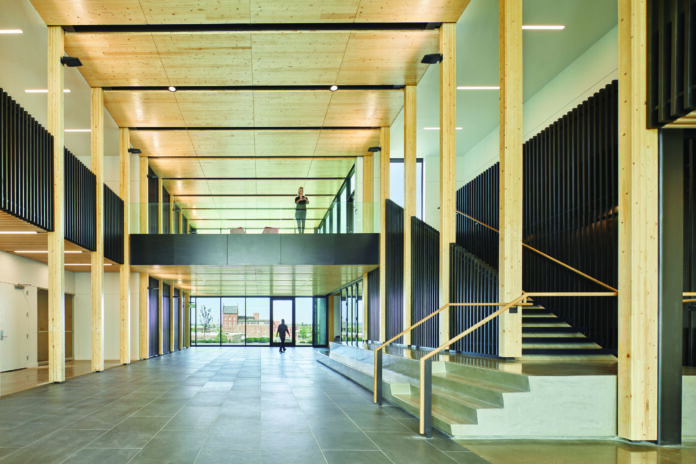For an efficient job and good results, the design, manufacturing and construction processes need to be viewed holistically.
Ricardo Brites is Director of Engineering at Mercer Mass Timber (MMT), which has manufacturing facilities in Arkansas, British Columbia and Washington state. The company’s Project Services office is in Vancouver, British Columbia. MMT is also supported by Mercer International in Berlin, Germany.
We talked with Brites about how DfMA [Design for Manufacturing and Assembly] applies to mass timber and what the benefits of using this approach are for builders and developers.

Q: What are the central principles of DfMA and how do they apply specifically to mass timber?
A: DfMA is the process of looking at design holistically. [It requires an] understanding of the impact of design decisions, not only on the structural aspects of the building — seismic performance, gravity loads, deflections, and so on— but also on the manufacture, transportation and assembly of the building.
Mass timber is a natural fit with DfMA because it’s prefabricated and manufactured offsite. Designers, manufacturers and installers together need to think through any potential problems at the earliest stages of a project — way before pieces arrive on-site.
We think about how a design can be more efficient in terms of material use, production and installation. We think about manufacturing feasibility, constructability and building sequence.
Q: What are some examples of things designers need to be aware of on a mass timber project that they don’t have to think about when designing a stick-built project?
A: One is that the size of the components handled during production tends to exceed the transport capacity. In our plant, we can easily create what’s called a ‘billet’ or master panel, which is 60 ft. long and 12 ft. wide. We cut smaller pieces from that massive panel.
The components are also heavier than parts for stick-building, so there needs to be a bit more engineering for lifting points, for the hoisting and bracing of these elements as they’re being installed on-site.
Mass timber components can be shipped flat packed, like an Ikea kit of parts, and then they’re screwed together on-site with long screws. The screws are engineered connectors that are very standardized and well established in the supply chain. Alternatively, our mass timber panels can be put together into 3D volumetric modules — either in one of our plants or by a third party — before being brought on-site, but, of course, mass timber modules are heavier than stick-framed equivalents.
The point is that how the mass timber is transported — in flat packs or in pre-assembled modules — needs to be considered, as does how the system will be erected on-site.

Credit: Benjamin Benschneider
Q: How should a builder or developer choose between a flat pack or volumetric modules for mass timber components?
A: Choosing volumetric modules means more work is completed offsite, which minimizes weather delays, for example. And having the factory deal with as much of the construction as possible means less risk on the job.
Although flat packs need much less on-site labor than stick-building — crews of five or 10 people can put a building together, rather than a crew of 20 or 30 carpenters — using volumetric modules reduces on-site labor even further. Dropping finished modules onto the site and connecting them requires less on-site labor than assembling flat-packed parts.
That said, it’s more efficient and less costly to transport flat packs than modules, but there are extra costs associated with unpacking and assembling the components at the jobsite. So, it really depends on how the developer or builder wants to manage risks and labor.
Q: What are the main advantages of mass timber for builders and developers?
A: When using mass timber, there’s less need for follow-on trades because you can leave some of the structure exposed, reducing the gypsum package by half or more. We see this done mostly on ceilings, but walls and columns can also be left exposed.
With prefabricated mass timber components, holes for services and all penetrations can be cut very precisely by the CNC machines, saving time and reducing the risk of errors at the jobsite. Using [flat-packed] mass timber components reduces the on-site schedule to about a third of the time needed for conventional on-site construction.
When producing shop drawings and CNC data, it makes no difference whether two pieces differ by 10 ft. or by a quarter of an inch. They’re still two different types of pieces. The more different pieces there are on a project, the more extra work there is at our end, and the higher the risk of error when unloading and assembling at the builder’s end. So, when it comes to elements that are very similar, but not quite the same, we work with the design team to see if we can adjust the design to reduce the number of unique pieces. [Writer’s note: This is an example of DfMA in action — manufacturing and assembly considerations informing design.]
In the end, the parts count is usually drastically reduced, by about half, compared to conventional construction.
Reducing the number of unique pieces also creates economies of scale for the manufacturer. Suppose, for example, we have 20 different wall options already designed. We can create a stock of those elements, virtually ready to ship, instead of creating one-off designs for each project every time. With the project design team, if we can tweak a design for a new building so that it can use those pre-designed walls, that saves time. It gets us closer to the process being as easy as going to Home Depot and picking what you want.
Using DfMA, we make sure we optimize what we can get from each billet. We can look beyond a single project and use sections in different projects to minimize waste, which in turn reduces price. (The pieces cut out for windows and doors are usually too small to use for another wall, but people have used them for furniture and shelves.)
With our guidance, the computer model also figures out the best sequence for assembly [which includes how they’re labelled, packed and loaded for transportation].

Credit: Ron Blunt
Q: What about cost?
A: Because of the level of detail in the 3D model, we can do really accurate pricing.
[On average] overall project costs are 37% lower when using mass timber than stick-building. A square foot of a CLT (Cross-Laminated Timber) wall is more expensive, in terms of material, than a square foot of stick-framed wall. But, when considering project costs holistically, mass timber is cheaper. There are savings on labor, on time spent on-site and — compared to concrete buildings — on the foundations. Mass timber creates a lighter above-grade structure than concrete, so it can have a lighter foundation.
A lighter structure also reduces seismic demands, as building mass correlates directly [to that]. This also has the positive impact of reducing foundation requirements.
In addition, the schedule is more reliable and predictable than stick-building, reducing the risk of expensive delays. The building is faster to market, so the developer can get a return on investment sooner. Taller buildings have more dramatic cost savings than two- or three-story buildings. (According to IBC, mass timber can be used up to 18 stories.)
People like spending time in wood environments. For example, high-end office space rents at a premium if they include exposed mass timber.
There’s an $80M building in Washington, DC that has three stories of mass timber added to it. The whole building was renovated, but offices on the mass timber floors were rented out soonest; they were the ones everybody wanted.
Q: Given these benefits, why is mass timber such a small part of the market in North America?
A: Probably the biggest barrier is fear of the unknown. Even though mass timber has been used in Europe for 20 or 25 years, it’s still relatively unknown here. Although it was here 20 years ago, it only started to gain traction 10 years ago, and much more so in the last five years.
Five years ago, we almost had to knock on people’s doors to tell them about this system. But there’s been an acceleration of interest and now people are knocking on our door, wanting to find out more after seeing presentations or videos or learning about it online.
Also, people may not know that there are now very few barriers regarding code compliance. Most have been resolved for the International Building Code. And for the rare non-compliant applications, examples have been built somewhere else in the world, so there are solutions for virtually every issue we encounter.
People also have the idea that it’s expensive, but that’s only if it’s not used correctly. If you just buy a couple of panels and try to figure things out on-site, the way you’ve always done with stick-building, that’s super-expensive, because the panels are big and heavy. It’s not unheard of for a panel to weigh 10,000 pounds, so you can’t just flip it around and cut it on-site. It needs very big machinery. But if you do it properly [with the cutting done offsite] it’s very cost efficient.
Finally, there’s also a lack of mass timber experts. An architect may be interested, and their client agrees to explore the idea, but then they get stuck because they don’t know where to go to get information.
Q: How realistic is it to start up a small business in mass timber, perhaps for building single-family homes and smaller apartment buildings?
If you want to control everything from beginning to end, it’s a huge investment. I think it would be in the region of $200 million to create a CLT factory.
But it’s realistic to set up as a secondary manufacturer, getting mass timber components from suppliers like Mercer. Green Canopy Node is an example of a small business we work with. They have a modular system, and we produce some components for them, which they assemble into modules.
You can add electrical conduits, gypsum board, weather protection membranes, and so on. It’s not efficient to do this on the CLT production line, which has a high throughput, but it’s easy to do in a smaller production facility.
Zena Ryder writes about construction and robotics for businesses, magazines, and websites. Find her at zenafreelancewriter.com.







